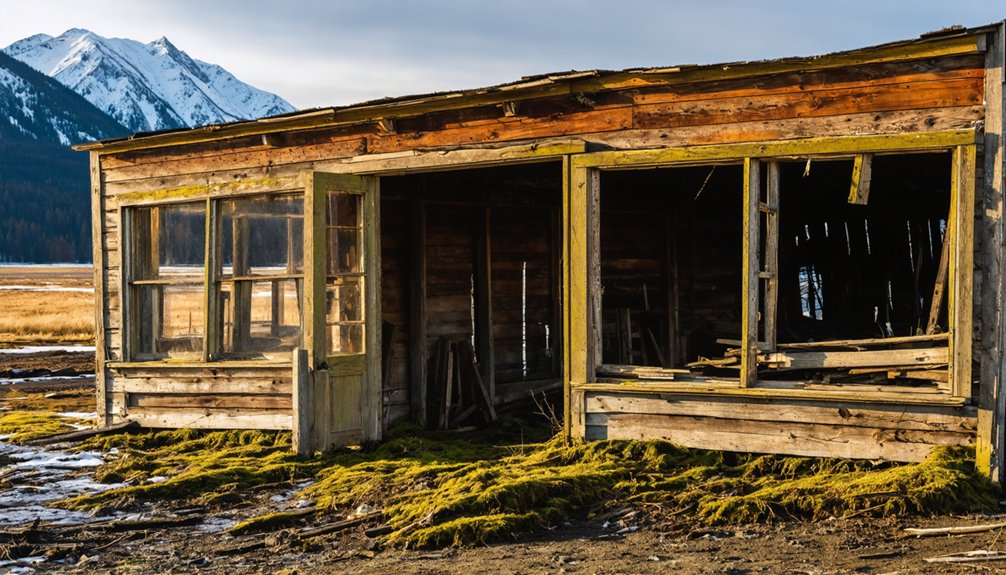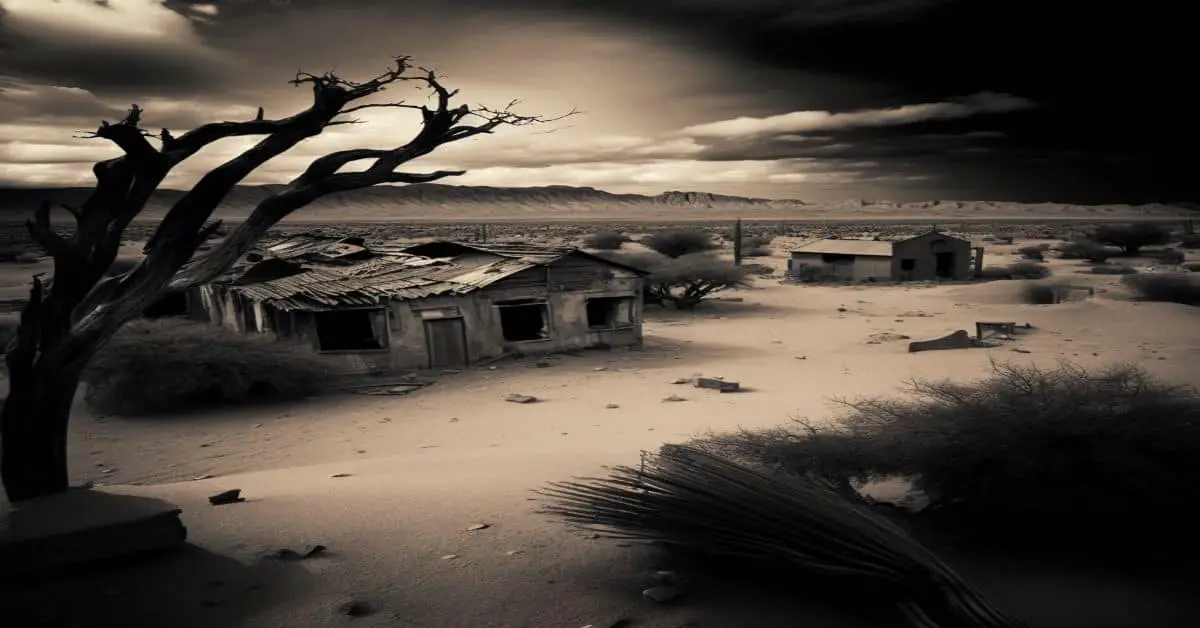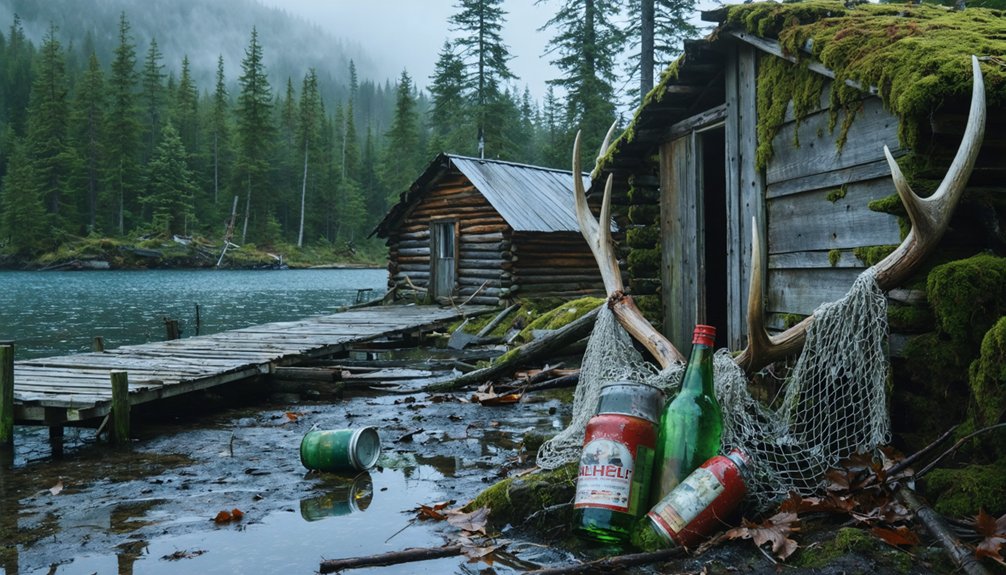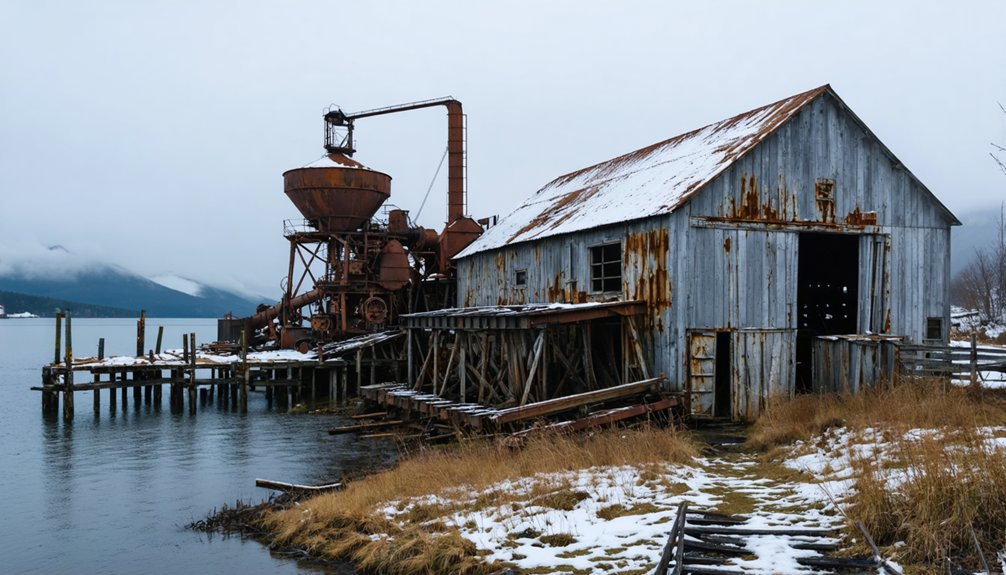You’ll find Dyea, Alaska as a haunting reminder of the 1897-98 Klondike Gold Rush, when it transformed from a Tlingit trading post into a bustling boomtown of 8,000 people. The town served as an essential gateway to the Chilkoot Trail until a devastating avalanche and the construction of Skagway’s White Pass & Yukon Route railroad sealed its fate. Today, only a single false-front wall remains where prospectors once crowded the streets, marking one of history’s most dramatic boom-to-bust stories.
Key Takeaways
- Dyea was a bustling Alaskan gold rush town that peaked at 10,000 residents in 1898 before becoming abandoned.
- The town served as a crucial gateway to the Klondike goldfields via the Chilkoot Trail during the 1897-1898 gold rush.
- A devastating avalanche and the construction of White Pass & Yukon Route Railroad in Skagway led to Dyea’s rapid decline.
- Dyea’s shallow harbor proved inadequate for large ships, contributing to its abandonment as miners favored Skagway’s deeper port.
- Today, only a single false-front wall remains of the original town, preserved by the National Park Service since 1976.
The Tlingit Legacy and Early Settlement Years
Long before Dyea became a gold rush boomtown, the Chilkat and Chilkoot Tlingit peoples established a profound presence in the region, building villages around Taiyasanka Harbor, Tanani, and along the river that would later define Dyea’s location.
Their ancestral connections to this land stretch back over three centuries, when clans migrated from Prince of Wales Island and other areas to create thriving settlements. According to ancient legends, their origins can be traced to two ocean sisters whose descendants formed the Tlingit and Haida nations.
You’ll find evidence of Tlingit traditions in archaeological discoveries, including 2,100-year-old fish traps and 800-year-old house remains.
The Tlingit’s historical significance extends beyond mere settlement – they created one of America’s largest trade networks, rivaling the Incas.
Their indigenous knowledge and cultural resilience helped them control essential trade routes, particularly the Chilkoot Pass, where they maintained exclusive rights and later guided early prospectors into the Yukon interior.
A pivotal moment came in 1879 when the Tlingit tribes reached an important trade agreement that allowed miners to access the previously restricted Chilkoot Pass.
From Trading Post to Gold Rush Gateway
In the mid-1880s, Healy & Wilson established a pivotal trading post near a Tlingit village that would transform Dyea’s destiny. Their wood-frame building, barn, and garden became the foundation for complex trading dynamics between prospectors and Alaska Natives, offering essential supplies and information for those venturing into the Yukon Basin.
You’ll find that cultural exchanges flourished at this strategic location, where the trading post served as more than just a supply depot – it became the seed from which Dyea’s future would grow. The name itself originates from the Tlingit word Dayéi, meaning to pack.
When news of the Klondike strike broke in July 1897, this humble outpost evolved into a bustling gateway. The trading post’s legacy laid the groundwork for Dyea’s explosive growth, as thousands of fortune-seekers would soon transform it into a major gold rush hub. By winter of 1897-1898, the town had grown to a staggering population of 8,000 at its peak.
Life During the Klondike Stampede
You’d find Dyea’s port teeming with anxious stampeders and freight companies as horses, dogs, and men jostled through the bustling waterfront, hauling supplies toward the dreaded Chilkoot Trail.
In the town’s hastily constructed shops and warehouses, merchants sold essential provisions at premium prices while competing freight operations vied for business among the desperate prospectors. The Tlingit people served as skilled guides and packers during this chaotic period. The trail ahead was notorious for being the meanest 32 miles a prospector would ever face.
Through the brutal winter of 1897-98, some 30,000 gold seekers endured freezing temperatures in makeshift tent cities, waiting for favorable conditions to tackle the treacherous mountain pass ahead.
Daily Commerce and Trade
During the height of the Klondike Gold Rush, Dyea transformed into a bustling commercial hub where fifteen freighting companies and countless merchants vied for stampeders’ business.
Tlingit guides established the local packing industry, charging fees to transport gear across the Chilkoot Pass while entrepreneurs rushed to meet the explosive supply demand of gold seekers required to carry a year’s worth of provisions. Located 600 miles south of the gold fields, Dyea became an essential staging point for miners preparing for their arduous journey north.
You’d find a town alive with commerce – hotels, saloons, and outfitters lined the streets while blacksmiths, carpenters, and tailors provided essential services.
At the waterfront, you’d see horses, sleds, and boats moving supplies from ships to staging areas.
Local businesses thrived as stampeders formed long lines at supply depots, though prices often soared due to scarcity and fierce competition with nearby Skagway.
Rush Hour at Port
Life at Dyea’s port brought an endless stream of activity as ships arrived packed with prospectors and their mandatory supplies.
You’d witness intense port congestion as thousands of gold seekers flooded the docks, each required by Canadian law to haul nearly a ton of provisions. The economic impact was immediate, transforming this remote Alaskan settlement into a bustling trade hub rivaling nearby Skagway.
- Ships constantly unloaded endless crates of equipment, food, and mining gear
- Prospectors scrambled to organize their mandatory year’s worth of supplies
- Local merchants thrived as they sold essential goods at premium prices
The port’s rush hour exemplified the raw determination of stampeders seeking their fortunes. The Inside Passage route became the primary waterway for vessels transporting eager prospectors from Seattle and San Francisco to Alaskan ports. Today, spruce and hemlock trees have reclaimed the once-bustling streets where thousands of fortune seekers once stood.
You’d find yourself caught in a whirlwind of commerce as both seasoned miners and greenhorns prepared for their arduous journey over the Chilkoot Trail toward the Yukon goldfields.
Survival Through Harsh Winters
When temperatures plummeted below zero in Dyea’s harsh winters, stampeders faced a brutal fight for survival along the Chilkoot Trail. You’d have found yourself among desperate men and women huddled in makeshift shelters and tents, battling the elements with whatever protection they could muster.
Winter survival meant relying on the year’s worth of provisions you’d hauled up those treacherous mountain passes. Community resilience proved essential as miners banded together, sharing resources and supporting one another through the darkest months. With a population that reached ten thousand by 1898, the crowded conditions only intensified the struggle to endure the season.
You couldn’t have made it alone – the threat of avalanches, disease outbreaks, and extreme cold demanded cooperation. In these remote conditions, your temporary settlements became lifelines, though they offered little comfort against nature’s fury.
Many waited out the winter in cramped quarters, knowing that one wrong move could mean death in this unforgiving wilderness.
The Fatal Avalanche That Changed Everything
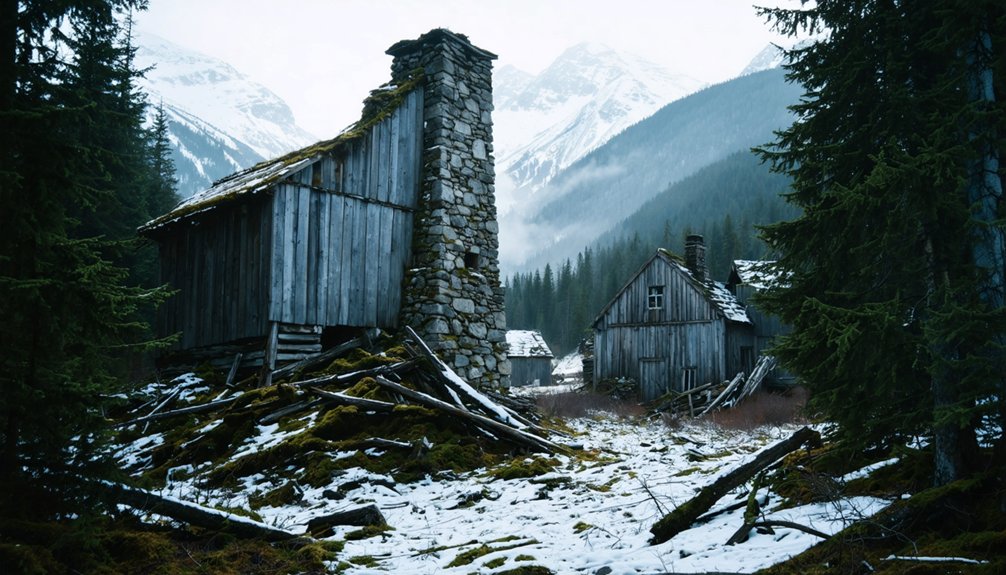
As spring snow blanketed the treacherous Chilkoot Trail on April 3, 1898, a series of devastating avalanches struck between Sheep Camp and the Scales, claiming the lives of approximately 65 gold seekers.
Despite clear warning signs of unstable snowpack and heavy snowfall, many stampeders ignored experienced miners’ advice to wait out the dangerous conditions. Their rush for riches would prove fatal.
- Initial survivor estimates varied wildly, with reports ranging from 10 to 50 people pulled from the snow.
- A makeshift morgue at Sheep Camp became overwhelmed as rescuers worked tirelessly for four days.
- Rival town Skagway spread rumors about the trail’s impassability to divert prospectors.
The disaster’s aftermath transformed Dyea forever.
Many stampeders abandoned the Chilkoot Trail route, accelerating the town’s decline into the ghost town you’ll find today, with only the Slide Cemetery remaining as a somber reminder.
Rise of Skagway and Dyea’s Swift Decline
You’ll find that harbor depth played a vital role in the competition between Dyea and Skagway, as larger ships could dock directly at Skagway’s wharves while Dyea’s shallow waters forced risky beach landings.
Skagway’s natural advantage grew even stronger when the White Pass & Yukon Route Railroad chose to build from its harbor, creating a permanent transportation link that Dyea couldn’t match.
The railroad’s arrival in 1898 effectively sealed Dyea’s fate, as stampeders and merchants abandoned the Chilkoot Trail in favor of Skagway’s modern rail connection to the interior.
Railroad’s Impact on Competition
The construction of the White Pass & Yukon Route railroad in May 1898 marked the beginning of Dyea’s rapid decline as Skagway’s dominant gateway to the Yukon goldfields. The railroad’s superior transportation capabilities quickly shifted the balance of power between the rival towns, establishing Skagway’s transportation dominance in the region.
- The first WP&YR train departed on July 20, 1898, offering stampeders a more efficient route over the coastal mountains compared to Dyea’s Chilkoot Trail.
- Railroad competition devastated Dyea’s economy when the harsh winter of 1898-1899 halted Chilkoot tramway operations.
- An April 1898 avalanche on the Chilkoot Pass brought negative publicity to Dyea’s trail, while Skagway capitalized by promoting its safer rail route.
This fierce transportation rivalry ultimately sealed Dyea’s fate, as businesses closed and residents abandoned the once-bustling boomtown for Skagway’s rail-connected prosperity.
Harbor Depth Proves Fatal
While Dyea initially attracted thousands of gold seekers during the Klondike rush, its shallow harbor proved to be a fatal weakness in competing with neighboring Skagway.
You’d have found Dyea’s harbor limitations severely restricted large vessels from docking, with a challenging tidal range extending more than a mile.
Even after building two wharves in 1898, the town couldn’t overcome these natural constraints. Ships had to unload cargo directly onto the beach, driving up labor costs as workers rushed to move goods before high tide struck.
Meanwhile, Skagway’s deep-water port offered safe, efficient docking for vessels of all sizes.
This key advantage, combined with Captain Moore’s strategic infrastructure development, accelerated Dyea’s economic downfall.
Walking Through a Modern Ghost Town
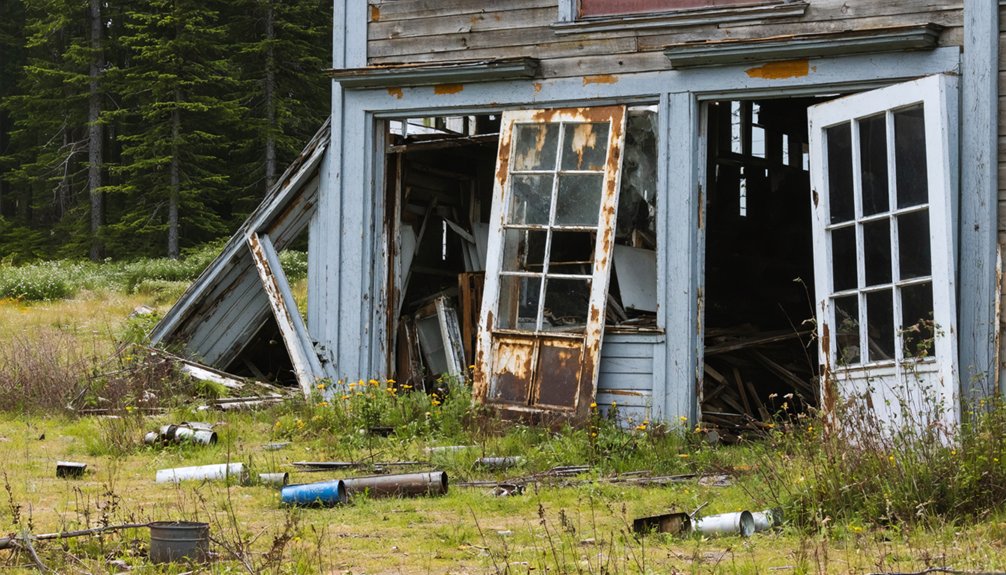
Stepping into modern-day Dyea feels like walking through time, as scattered ruins and foundation outlines replace what was once a bustling Gold Rush boomtown of 8,000 people.
You’ll discover a site steeped in Tlingit heritage, where “Dayéi” marked an ancient trading post long before gold fever struck. Today’s ghost town reveals its secrets through interpretive signs and self-guided walking tours.
- Explore warehouse remnants and the A.M. Gregg Real Estate Office foundations
- Follow official maps through the historical street grid that’s now barely visible
- Wander freely among scattered homesteads that dot the historic landscape
You can access this time capsule easily from Skagway, just 9 miles away via the Klondike Highway, where clear signage guides you to designated parking for your walking adventure.
Preserving Alaska’s Gold Rush Heritage
Since 1976, dedicated conservation efforts by the National Park Service have protected Dyea’s gold rush legacy as part of the Klondike Gold Rush National Historical Park.
You’ll find historical preservation work focused on the town’s last remaining structure – a false-front wall that’s now threatened by the westward-shifting Taiya River. In 1997, park employees treated this precious remnant with fungicide and replaced damaged boards to guarantee its survival.
The site’s cultural significance stems from its role as an essential gateway for prospectors heading to Yukon gold fields via the Chilkoot Trail.
Through joint management with Parks Canada, you can explore interpretive programs that bring the boomtown’s brief but remarkable history to life, connecting you with the spirit of adventure that drove thousands to seek their fortunes here.
Frequently Asked Questions
What Happened to the Original Buildings and Materials From Abandoned Dyea Structures?
You’ll find building materials were sold for profit, reused in local farming operations, while natural disasters destroyed many structures. Despite preservation efforts, only minimal remnants survive in the archaeological site today.
Are There Any Known Buried Treasures or Artifacts Still Awaiting Discovery?
You’ll find no documented buried treasures, though undiscovered artifacts likely remain scattered beneath soil and vegetation. Treasure hunting isn’t permitted, as the area’s protected under federal preservation laws.
How Do Visitors Reach Dyea Today and What Permits Are Required?
You’ll reach Dyea via Skagway by driving 9 miles along Klondike Highway and Dyea Road. No special permits needed for visiting, though you’ll want camping permits ($10/night) if staying overnight.
What Wildlife Commonly Inhabits the Former Dyea Townsite Now?
You’ll spot brown and black bears, harbor seals, eagles, and diverse woodland birds throughout the preserved habitat. During salmon runs, the area teems with marine mammals and migratory shorebirds.
Do Any Descendants of Original Dyea Residents Still Live in Alaska?
While you’ll find some descendant stories from the Tlingit communities in nearby Klukwan, there’s no clear record of gold rush-era family ties continuing in Dyea itself or documented descendants living in Alaska.
References
- https://www.juneauempire.com/life/southeast-in-sepia-the-dyea-townsite/
- https://www.legendsofamerica.com/dyea-alaska/
- https://en.wikipedia.org/wiki/Dyea
- https://www.miningnewsnorth.com/story/2021/07/30/northern-mining-history/dyea-alaska-the-lost-sibling-to-skagway/6911.html
- https://www.nps.gov/klgo/learn/photosmultimedia/dyea-waysides.htm
- https://www.whatsupyukon.com/yukon/history/forgotten-town-dyea-the-town-alaska-forgot/
- https://www.skagway.com/listing/historic-dyea-townsite/463/
- https://www.nps.gov/media/video/view.htm?id=4BDE74ED-D4B8-A5C1-D6789B7786AFBCF9
- https://www.youtube.com/watch?v=l_AQsxy1Jm8
- https://www.nps.gov/klgo/learn/historyculture/dyea.htm
